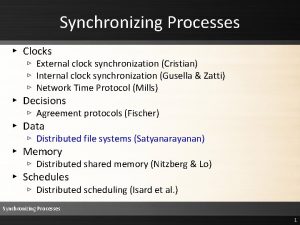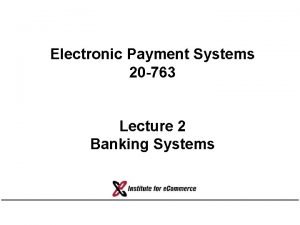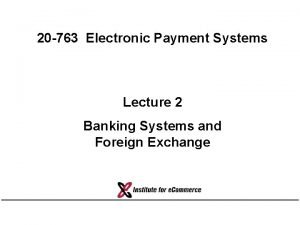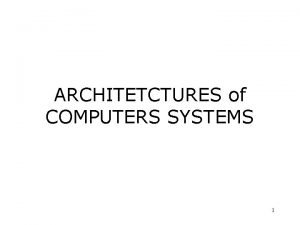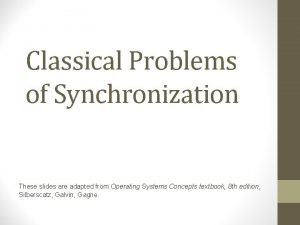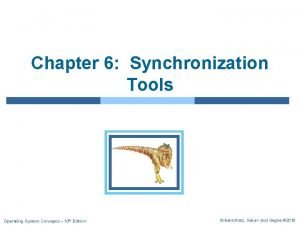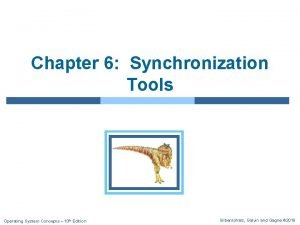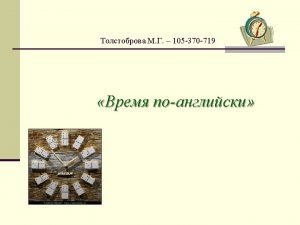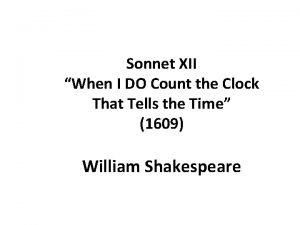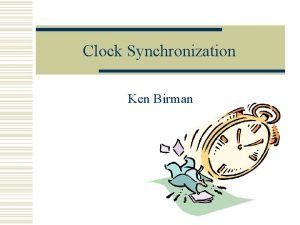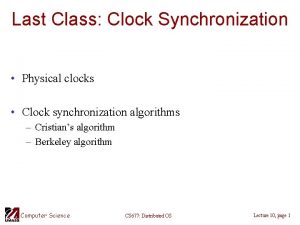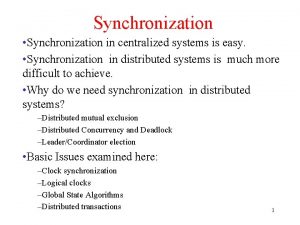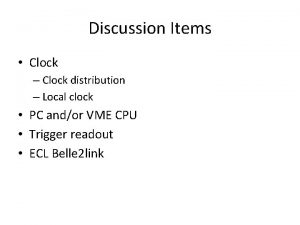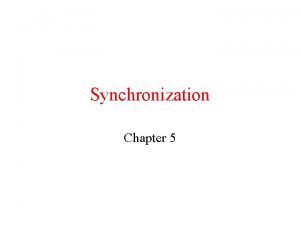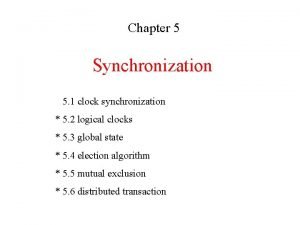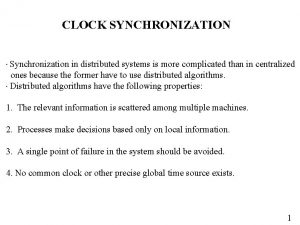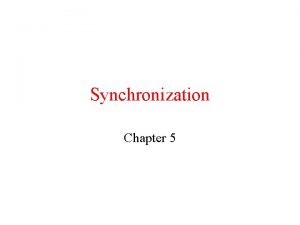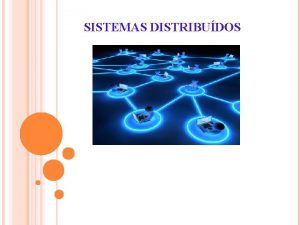Synchronization Clock Synchronization In a centralized system time























- Slides: 23

Synchronization

Clock Synchronization In a centralized system time is unambiguous. In a distributed system agreement on time is not obvious. When each machine has its own clock, an event that occurred after another event may be assigned an earlier time.

Clock Synchronization Algorithms If 1 – r < d. C/dt < 1 + r r maximum drift rate Resynchronization interval d/2 r d maximum time difference The relation between clock time and UTC when clocks tick at different rates.

Cristian's Algorithm synchronization with a time server • Time must never run backward gradual changes • Non zero message propagation time

The Berkeley Algorithm synchronization without time server a) b) c) d) The machines answer The time daemon asks all the other machines for their clock values The time daemon tells everyone how to adjust their clock no Universal Coordinated Time available

• Centralized algorithms have disadvantages. • Decentralized algorithms can use averaging methods. • NTP (Network Time Protocol) provides an accuracy of 1 -50 msec using advanced algorithms. • For many purposes it is sufficient that all machines agree on the same time. Logical clocks

Lamport Timestamps If a b C(a) < C(b) If a sen. , b rec. C(a) < C(b) C(a) C(b) If C(a) < C(b) C(a) = C(b)+1 We obtain a total ordering of all events in the system Lamport timestamps don’t capture causality Vector timestamps

Global State it is the local state of each process, together with the messages currently in transit a distributed snapshot reflects a consistent global state

Global State any process P may initiate the algorithm recording its local state. Organization of a process and channels for a distributed snapshot a) A process P sends a marker along each of its outgoing channels

Global State b) c) d) Process Q receives a marker for the first time and records its local state Q records all incoming message Q receives a marker for its incoming channel and finishes recording the state of the incoming channel A process has finished its part of the algorithm when it has received a marker along each of its incoming channels, and processed each one. Many snapshots may be in progress at the same time.

The Bully Algorithm Selecting a coordinator The bully election algorithm a) Process 4 holds an election b) Process 5 and 6 respond, telling 4 to stop c) Now 5 and 6 each hold an election

d) e) Process 6 tells 5 to stop Process 6 wins and tells everyone

Mutual Exclusion: critical regions in distributed systems A Centralized Algorithm a) b) c) Process 1 asks the coordinator for permission to enter a critical region. Permission is granted Process 2 then asks permission to enter the same critical region. The coordinator does not reply. When process 1 exits the critical region, it tells the coordinator, which then replies to 2

A Distributed Algorithm requires a total ordering of all events in the system a) b) c) Two processes (0, 2) want to enter the same critical region at the same moment. Process 0 has the lowest timestamp, so it wins. When process 0 is done, it sends an OK also, so 2 can now enter the critical region. d) This algorithm is worse than the centralized one, but possible

A Toke Ring Algorithm start a) b) An unordered group of processes on a network. A logical ring constructed in software.

Comparison Messages per entry/exit Delay before entry (in message times) Problems Centralized 3 2 Coordinator crash Distributed 2(n– 1) Crash of any process Token ring 1 to 0 to n – 1 Lost token, process crash Algorithm A comparison of three mutual exclusion algorithms.

The Transaction Model A transaction permits that a whole set of related instructions would be successfully completed or none would be completed. Special primitives are requested Primitive Description BEGIN_TRANSACTION Make the start of a transaction END_TRANSACTION Terminate the transaction and try to commit ABORT_TRANSACTION Kill the transaction and restore the old values READ Read data from a file, a table, or otherwise WRITE Write data to a file, a table, or otherwise Examples of primitives for transactions.

The Transaction Model Transactions are ACID: • Atomic : to outside, they happen indivisibly • Consistent : they don’t violate system invariants • Isolated : concurrent transactions don’t interfere • Durable : the changes are permanent

Distributed Transactions a) b) A nested transaction (it follows a logical division of the work) A distributed transaction (it is logically flat and operates on distributed data)

Private Workspace a) b) c) The file index and disk blocks for a three-block file The situation after a transaction has modified block 0 and appended block 3 After committing

Writeahead Log x = 0; y = 0; BEGIN_TRANSACTION; x = x + 1; y=y+2 x = y * y; END_TRANSACTION; (a) Log Log rollback [x = 0 / 1] (b) [x = 0 / 1] [y = 0/2] (c) [x = 0 / 1] [y = 0/2] [x = 1/4] (d) a) A transaction b) – d) The log before each statement is executed In distributed systems each machine keeps its own log of changes to its local file system

Concurrency Control allows several transaction to be executed simultaneously leaving data in a consistent way General organization of managers for handling transactions .

Concurrency Control General organization of managers for handling distributed transactions.
 Fast clock to slow clock synchronization
Fast clock to slow clock synchronization Physical clock synchronization in distributed system
Physical clock synchronization in distributed system External clock synchronization
External clock synchronization For 1 minute
For 1 minute Institutional catering definition
Institutional catering definition Site:slidetodoc.com
Site:slidetodoc.com Centralized public grievance redress & monitoring system
Centralized public grievance redress & monitoring system Centralized banking system
Centralized banking system Centralized computer system
Centralized computer system Drug basket system
Drug basket system Charge floor stock system
Charge floor stock system Classical problems of synchronisation
Classical problems of synchronisation Synchronization tool in os
Synchronization tool in os Which one of the following is a synchronization tool?
Which one of the following is a synchronization tool? Elapsed time
Elapsed time 24 hours time
24 hours time Time 24 hour clock
Time 24 hour clock With money you can buy
With money you can buy Five past quarter
Five past quarter Timeclock plus mpsaz
Timeclock plus mpsaz 24 hour table
24 hour table Sonnet xii
Sonnet xii Mitc clock in
Mitc clock in With money you can buy clock not time
With money you can buy clock not time


